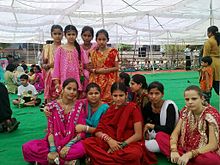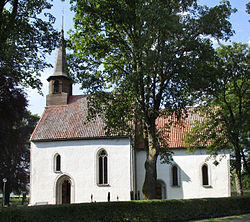메활
Meghwal 인도 잠무의 메그걸 그룹 | |
| 인구가 많은 지역 | |
|---|---|
| • 인도 • 파키스탄 | |
| 종교 | |
| •힌두교 • 불교 (나바야나) |
메그왈 또는 메그와르(Meghwar, Megh and Megraj라고도 함) 메그왈은 신드에서 유래한 장인의 카스트이며 나중에 북쪽, 남쪽, 동쪽, 서쪽으로 이주했습니다.[2] 그들의 전통적인 직업은 농업, 목축, 직조였습니다. 메그왈스는 자수와 섬유 산업에 기여한 것으로 유명합니다. 그들 대부분은 종교적으로 힌두교이며 리시 메그, 카비르, 람데브 피르에게 특별한 경의를 표합니다.[3]
동의어
메그왈 공동체는 위치에 따라 다양한 이름으로 알려져 있습니다. 그 예로는 발라이, 멩와르 등이 있습니다.[4] 이 공동체는 또한 부정적인 것으로 간주되는 Dhed뿐만 아니라 중립적인 용어인 Bhambhi로 알려져 있습니다.[5][6]
오리진스
그들은 기도를 통해 구름에서 비를 가져오는 힘을 가진 성인 리시 메그의 후손이라고 주장합니다.[7] 메그와르라는 단어는 구름과 비를 의미하는 산스크리트어 메그와 집단, 아들과 아이를 의미하는 전쟁 (힌디: वार)에서 유래되었습니다. (산스크리트어: वार:)
그러나 무슬림의 인도 침공 당시에는 라즈푸트, 샤란, 브라만, 자트 등 고위 카스트의 많은 사람들이 밤비나 메그왈 카스트에 가입하거나 모집되었다고 합니다. 이로 인해 커뮤니티에는 다음과 같은 5개의 주요 부서가 있었습니다.[9][10][11][12]
- 혼합되지 않은 아두르 밤비스,
- Rajputs로 구성된 Maru Bhambis,
- 차라니야 밤비스는 차라나스를 포함해서,
- 팔리왈 브라만으로 구성된 밤니아 밤비스
- 야트족을 포함한 야타밤비스족
일부 메그왈들은 다른 사회 단체들과 연관되어 있습니다. 샤얌 랄 라왓(Shyam Lal Rawat)은 라자스탄(Rajasan)의 메그왈스(Meghwals)를 "지배적인 후진 카스트 중 하나"[13]라고 언급하며, 이는 데바시스 데브나트(Debashis Debnath)가 만든 연결고리이기도 합니다.[14] 발랄리와 분카르 공동체도 메그왈이라는 이름을 사용하기 시작했습니다.[15]
문화
메그왈의 하위 집단들 사이에는 문화적 차이가 존재합니다. 예를 들면, 라자스탄의 야타 밤비스, 밤니아 밤비스, 그리고 샤라니아 밤비스와 같은 메그왈은 다른 하위 계급에서 결혼하지 않습니다. 이전의 정체성에 대해 더 의식하는 이러한 하위 그룹은 오래된 관습과 전통을 유지합니다.[11][12]
게다가, 다른 하위 그룹들 사이에서 옷 입는 습관에서도 상당한 다양성이 있었습니다. 1891년, 하르디얄 싱이 마르와르의 메그왈 카스트인 밤비에 대해 썼을 때,[4][11][12] 그는 다음과 같이 관찰했습니다.
"앞의 두 사단(아두족 또는 혼합되지 않은 밤비스족과 마루족 밤비스족)은 매우 밀접하게 연결되어 있고 서로 결혼하는 반면, 뒤의 두 사단은 각각 자신의 공동체에서만 결혼합니다. 밤비 부부는 금과 은으로 된 장신구를 착용할 수 없지만, 본가 밤비 부부의 경우는 예외입니다. 남성들의 드레스에서 두드러진 인기가 있지만 마루밤비 여성들은 일반적으로 시골 진츠의 가그라나 페티코트를 입는 반면, 자타밤비 여성들은 자트 여성들처럼 옷을 입고 상아 대신 라쿠라를 사용하는 것과 구별됩니다. 샤라니아 밤비스의 여인들은 샤란 여인들처럼 노란색 옷을 입습니다."
구자라트에서는 마헤스와리 메그왈스를 제외한 마르와다, 구자라, 차라니야의 메그왈스 하위 구역이 마타를 숭배합니다. 게다가, 차라니야 메그왈들과 대조적으로, 마르와다족과 구자라 메그왈들은 성인 람데브 푸리에 대해 큰 존경심을 가지고 있습니다. 마헤슈와리 메그왈들과 달리, 마르와다 메그왈들은 합창단이나 결혼식 제단을 가지고 있습니다. Charaniya Meghwals는 Meghwals의 전통적인 스킨십과 태닝 활동을 자제하는 반면, 다른 그룹들은 그러한 일에 참여하는 것에 대해 특별한 반대를 보이지 않습니다.[16][17]
지리적 분포
메그왈은 구자라트, 마디아프라데시, 마하라슈트라, 라자스탄에서 발견됩니다.[citation needed] 메그족, 카비르 판티족, 바갓족은 히마찰프라데시족, 잠무족, 카슈미르족[18] 출신으로 메그족, 아리아 메그족, 바갓족으로 알려져 있습니다. 일부 지역에서는 가네샤, 메그반시, 미하, 라케사르, 라키아, 리키아, 리샤 등의 이름으로 알려져 있습니다. 마하들 중 일부는 메그들의 것이라고 주장하기도 합니다.[19][need quotation to verify] 1947년 인도 분할 이후 힌두교로 개종한 메그족은 인도 영토로 이주해야 했습니다.[20][need quotation to verify]
1991년 현재 펀자브(인도)의 메그족 인구는 105,157명으로 추정됩니다.[21]
라이프스타일
라자스탄의 시골에는 아직도 이 공동체의 많은 사람들이 형형색색의 기하학적 디자인과 세부적인 거울 무늬로 장식된 둥근 진흙 벽돌로 된 오두막의 작은 마을에 살고 있습니다.[citation needed] 초기 메그왈 공동체의 주요 직업은 농업 노동, 직조, 특히 카디와 목공예였으며, 이들은 여전히 주요 직업입니다. 여성분들은 자수 작업으로 유명하고 명모와 면직입니다.[22][23]
오늘날 점점 더 많은 메그왈족들이 교육을 받고 정부의 일자리를 얻고 있습니다. 펀자브에서는 특히 암리차르, 잘란다르, 루디아나와 같은 도시에서 상당수가 스포츠, 양말, 수술 및 금속 제품을 생산하는 공장에서 노동자로 일하고 있습니다. 그들 중 소수만이 자신의 사업이나 소규모 산업을 가지고 있습니다. 소규모 사업 및 서비스 부서는 생계를 위한 주요 지원입니다.[24]
예술
라자스탄의 메그왈 여성들은 화려하고 세부적인 의상과 보석으로 유명합니다. 결혼한 여성들은 곧 남편이 될 어머니가 준 "신부" 지참금으로 금으로 된 코 반지, 귀걸이, 목도리를 자주 착용합니다. 코 반지와 귀걸이는 종종 루비, 사파이어, 에메랄드의 귀중한 돌로 장식됩니다. 메그왈 여성 자수를 찾고 있습니다. 그들의 작업은 으깨진 곤충에서 생산된 지역 색소에서 나오는 붉은 색을 주로 사용하는 것으로 특징지어집니다. 신드와 발로치스탄의 타르 사막과 구자라트의 메그왈 여성 장인들은 전통적인 자수와 랄리 제작의 대가로 여겨집니다. 이국적인 핸드 자수 아이템은 메그왈 여성의 혼수품입니다.[25]
참고 항목
참고문헌
- ^ Sharan, Madhu; Shah, Mitali; Agrawal, Dolly (2 October 2023). "Indigenous Heritage of Traditional Embroidery Practiced by Meghwal Community". ShodhKosh: Journal of Visual and Performing Arts. 4 (2): 325–338. doi:10.29121/shodhkosh.v4.i2.2023.591. ISSN 2582-7472.
- ^ rti_admin (24 February 2019). "Exploring the Narrative History and Experiences of Meghwal Community: An Ethnographic Study". Round Table India. Retrieved 29 January 2024.
- ^ Khan, Dominique-Sila (April 1996). "The Kāmaḍ of Rajasthan — Priests of a Forgotten Tradition". Journal of the Royal Asiatic Society of Great Britain & Ireland. 6 (1): 29–56. doi:10.1017/S1356186300014759. S2CID 162210744. Archived from the original on 30 September 2022. Retrieved 5 June 2010.
- ^ a b Pathak, Bindeshwar (1998). Continuity and Change in Indian Society: Essays in Memory of Late Prof. Narmadeshwar Prasad. Concept Publishing Company. ISBN 978-81-7022-726-7. Archived from the original on 27 January 2024. Retrieved 18 November 2021.
- ^ Vyas, V. S. (2007). Rajasthan, the Quest for Sustainable Development. Academic Foundation. p. 350. ISBN 978-81-7188-621-0. Archived from the original on 12 August 2023. Retrieved 12 August 2023.
A unique feature of Rajasthan has been that each occupational caste has three names—one, which is respectful, the second which is general and third which is demeaning. For instance, a leather worker would be respectfully addressed as Meghwal, the neutral term is Bhambhi and is despairingly referred as Dhed.
- ^ a b Snodgrass, Jeffrey G. (10 August 2006). Casting Kings: Bards and Indian Modernity. Oxford University Press. p. 182. ISBN 978-0-19-804140-5. Archived from the original on 12 August 2023. Retrieved 12 August 2023.
Rajasthani castes typically have three names: one respectful, one neutral, and one demeaning (Kothari 1994: 205). In this case Bhambhi is the most neutral of the three terms. Meghwal is used by Bhambhis to make a higher status claim—specifically, that they are descended from the Hindu saint Megh. Balai, on the other hand, is used to refer to this community's sometimes role as a village or town crier, referred to as a ganv balai, or even a royal crier in the service of the king, called a raj balai.
- ^ "Regional Briefs, Punjab, Abohar". Retrieved 24 August 2009.[영구적 데드링크]
- ^ Alok Kumar Rastogi & Shri Sharan. Supreme Sanskrit-Hindi Kosh. Kalra Publications (Pvt.) Ltd., Delhi.
- ^ Pathak, Bindeshwar (1998). Continuity and Change in Indian Society: Essays in Memory of Late Prof. Narmadeshwar Prasad. Concept Publishing Company. pp. 199, 200. ISBN 978-81-7022-726-7. Archived from the original on 27 January 2024. Retrieved 18 November 2021.
I shall briefly discuss the Chamars, Balais, Bhambis and Meghwals of Rajasthan. The term "Adak" was used for the traditional Chamars in general, whereas the term "Sadak" was used particularly for those converted Chamars who were recruited in the Chamar castes from higher castes. This conversion is elaborated in Munshi Hardayal Singh's description of how members of the Brahmin, Rajput, Jat and Charan castes in Rajasthan were lowered.
- ^ Choudhry, P. S. (1968). Rajasthan Between the Two World Wars, 1919-1939. Sri Ram Mehra. p. 81. Archived from the original on 27 January 2024. Retrieved 25 February 2022.
There are four divisions amongst them, each division claiming to have sprung from a higher caste, viz. : 1. Adu or unmixed Bhambhis; 2. Maru the descendants of Rajputs; 3. Jata the descendants of Jats, and 4. Charanya, the descendants of a Charan.
- ^ a b c Shyamlal (1997). From Higher Caste to Lower Caste: The Processes of Asprashyeekaran and the Myth of Sanskritization. Rawat Publications. pp. 63, 64. Archived from the original on 27 January 2024. Retrieved 17 January 2022.
- ^ a b c Channa, Subhadra Mitra; Mencher, Joan P. (30 May 2013). Life as a Dalit: Views from the Bottom on Caste in India. SAGE Publications India. p. 124. ISBN 978-81-321-1777-3. Archived from the original on 27 January 2024. Retrieved 17 January 2022.
- ^ Rawat, Shyam Lal (2010). Studies in Social Protest. Rawat Publications. pp. xiv, 356. ISBN 978-8131603314.
- ^ Debnath, Debashis (June 1995). "Hierarchies Within Hierarchy: Some Observations on Caste System in Rajasthan". Indian Anthropologist. 25 (1): 23–30. JSTOR 41919761.
- ^ Dalit Women in Rajasthan: Status of Economic, Social & Cultural Rights (PDF). Archived (PDF) from the original on 26 November 2012. Retrieved 22 July 2013.
- ^ Gupta, Dipankar (2000). Interrogating Caste: Understanding Hierarchy and Difference in Indian Society. Penguin Books India. p. 83. ISBN 978-0-14-029706-5. Archived from the original on 12 August 2023. Retrieved 12 August 2023.
- ^ Gupta, Dipankar (1984). "Continuous Hierarchies and Discrete Castes". Economic and Political Weekly. 19 (47): 2003–2005. ISSN 0012-9976. JSTOR 4373801. Archived from the original on 12 August 2023. Retrieved 12 August 2023.
Within caste groups too the endogamous jatis are also separated by divergent customs.
- ^ "Census India - Govt. of India". Archived (PDF) from the original on 27 March 2020. Retrieved 30 January 2020.
- ^ Mark Juergensmeyer. (1988). Religious Rebels in The Punjab: The Social Vision of Untouchables. Ajanta Publications, Delhi. p. 214. ISBN 81-202-0208-2.
- ^ Mark Juergensmeyer. (1988). Religious Rebels in The Punjab: The Social Vision of Untouchables. Ajanta Publications, Delhi. p. 225. ISBN 81-202-0208-2.
- ^ "Dalits – On the Margins of Development" (PDF). Archived from the original on 21 July 2011. Retrieved 15 August 2009.
{{cite web}}: CS1 maint: 잘못된 URL (링크) - ^ "Weaving a common destiny". Centre for Science and Environment. June 1992. Archived from the original on 18 July 2011. Retrieved 15 August 2009.
- ^ "Ancient Lac Dyeing Practices of Kachchh and its revival by the Vankar Shyamji Valiji of Bujodi". Craft Revival Trust. Archived from the original on 19 July 2011. Retrieved 15 August 2009.
- ^ Bal, Gurpreet; Judge, Paramjit S. (2010). "Innovations, Entrepreneurship and Development". Journal of Entrepreneurship. 19: 43–62. doi:10.1177/097135570901900103. S2CID 154601153. Archived from the original on 8 March 2010. Retrieved 11 April 2010.
- ^ Jasleen Dhamija; Crafts Council of India (2004). Asian embroidery. Abhinav Publications. p. 125. ISBN 81-7017-450-3.
외부 링크
 위키미디어 커먼즈의 메그왈 관련 미디어
위키미디어 커먼즈의 메그왈 관련 미디어


